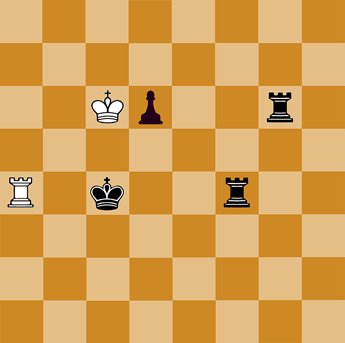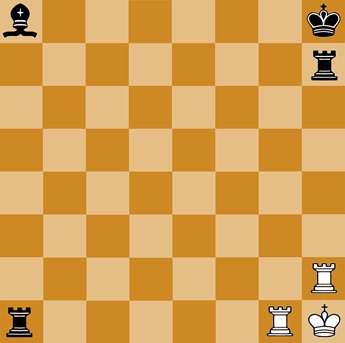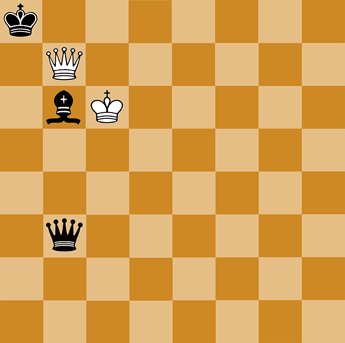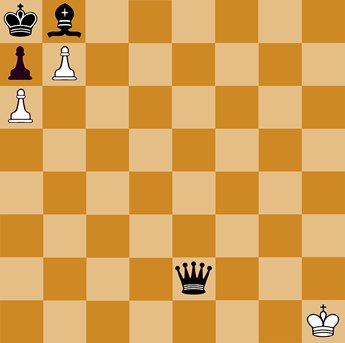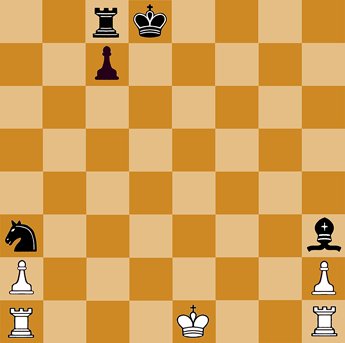|
1. It is a good idea to practice with a friend and to invent exercises, for instance: How many different moves can the White pawn on c2 make in the position White: K on c3, P on c2, Black: K on c5, B on d3?.-One move. It can capture the Bishop. It cannot advance straight forward because it is blocked. 2. What points are accessible in one move to a White Kt on QKt3, the White K being placed on QB5 with no other White man on the board?-The five points: QR1, QB1, Q2, Q4, QR5. 3. The position is White K on QB1, P on Q2, Black K on his K4, P on his K5 and his K7. White to play moves 1 P-Q4 check. Black can capture the pawn in two ways, by the K or by taking it en passant. 4. White K on QR1, R on QKt2, B on QKt1, P's on QR2, QR3. Black K on QR5 (Whites QR4), Q on QB6, R on QB8. White to play. How many legal moves can White make?-None, he is not permitted to expose his K. His P's are blocked. 5. What is the shortest number of moves in which a Kt on b2 can occupy f8? Four, moves. It can accomplish that journey within that time in various ways.-Find them out. The object of the player is to capture the hostile King by force or, if that cannot be accomplished, at least to defeat the attempt of the opponent to capture his. A move which menaces the capture of the King is called “check.” If the opponent cannot defend the King against the check it is termed “check and mate,” or “Checkmate,” or, still more briefly, “mate.” These words originate from Persia. Check means Shah, monarch and mate signifies death. Put the following positions up on the board and make sure that you understand both the positions and the explanations appended to each: The chess house player needs to practice on a regular bases in order to become adept of the game of chess. White K on g1, R on e8: Black K on g8, pawns on f7, g7, h7,-Black is check and mate, or mated. White: K b1, Q f6; Black: K g8, Q b2, pawn c3,-White is mated. White: K e1, Rs on a7 and b7; Black: K g8, Rs g2 and c1,-White is mated. White: K a1; Black K g8, Q c2. White to play has no legal move, but he is not in check, he therefore does not lose the game. It ends then and there as a drawn battle. The mate is “stale”-a “stalemate.”
When players do not terminate the contest by agreement they have to continue until one of the following situations arises; Checkmate: The person whose King has been checkmated loses the game. Stalemate: The person whose turn it is to move has no legal move left, but whose King is not in check, is no worse off than the opposing person. Such a game is drawn. Repetition of moves: After the same position has arisen 3 times with the same person the game is drawn.
1. Black is in check. He cannot capture the checking piece nor can he stay were he is, but must move his K. Then White captures the Rook on f4.
2. White is in check and as he cannot capture the checking piece,move his King out of the line of the attacking piece, nor legally use one of his own pieces, he is checkmated. In other words the game is over and White has lost.
3. Show how it is that Black has lost.
4. Say whose turn it is to move and if the game is finished, state the result.
5. Neither the White K or either of his Rs has been moved in this game. White to play can castle Q side, but may not castle K side. Why? 6. White: K c1, R g6, P f7. Black: K h7, Q h8, Kt g8. White to play, wins. How ? By f7-f8, promotes the P to a Kt and mates. 7. White: K on KKt1, Q on K6, Kt on KB7. Black: K on KKt1, Rs on QR1 and K1, P's on KKt2, KR2. White to play. He moves 1 Kt-KR6, which is check by the Kt as well as “discovered” check by the Q, a “double check,” in reply to which Black must move his K. Why? Show also how White wins. 8. White: K on KKt6, Q on QR2, R on QKt1. Black: K on Kr1, R on QR1, B on KKt7, P on KKt2. What would Black do if White played Q x R ch? What advantage does White gain by that sacrifice? 9. White Kt on K4, Black K on K1. Can the White Kt by making an appropriate move say check? It can. In how many different ways?In two ways. Point out the two moves that give check. 10. White R on K1, Kt on K4. Black K on K1, Q on Q1, B on KB1, P on KB2. White to move his Kt and checkmate the Black King by means of a double check. 11. White K on KR1, P on KB7. Black K on KR2, Q on KKt3, P's on KKt2 and KR3. White to play and say check, and win the Blacks Queen. 12. White Q on QKt3, Kt on KKt5. Black K on K1, Q on Q1. White to play and mate. The student should invent similar exercises for him/herself until he becomes completely familiar with all the movements of all the pieces.
1. The thought which follows is not distancing itself from chess house playing, although it refers to no move or position. If chess was not invented to show the twofold method which will be explained shortly, it does demonstrate the method exceedingly well on many instances. This method can be applied whenever you need to achieve a goal. This method teaches how to approach an objective in two different ways. Firstly, by concentrating his attention on the end result, secondly by paying attention solely to the needs of the present. These two procedures are opposed to each other. He who successfully reasons out the moves necessary to achieve the end result has solved the task set him. He who successfully meets the needs of the present, is not certain of the future and may be disappointed by the final results. On the other hand, he who goes the long way has considerably more effort to give in the present, whereas he who is satisfied with discovering only the next step has an easy time.
Consequently we must combine and use the two procedures together. The question is perhaps shown more vividly by the following imaginary example: A treasure seeker knows that in a certain location, there exists a treasure, which is defended by many guards. To obtain the treasure he has to approach it and overcome or evade the guards which he meets on the way. He will be well advised to improve his chances step by step. After having approached his objective, the tactics of proceeding step by step would lead him no further. He must now ascertain the exact place which holds the treasure and consider whether he should attack the few guards which still separate him from it. If his force is equal to this task, provided he chooses the line of least resistance, he must attack swiftly. If his force is not equal to this task he must first gather more strength. To arrive at a decision he has to apply deduction intelligently. He can do so because after he has approached his objective, the number of possibilities to be investigated, which at the start of his adventure was enormous, is reduced now to only a few.
I want to teach my pupil how to become primarily a natural player who doesn’t have to strain his memory, who applies logic only when deduction is called for, and who has sufficient experience or knowledge to back him up in novel situations, for the natural player has an advantage in chess as in life. The book player follows the standard of games played by masters, and to do so, must commit to memory a large number of isolated facts, The natural chess house player relays on his judgment, which he must cultivate in order to succeed. In life isolated facts are of little value, whereas sound judgment is needed on all sides. Great masters are always natural players, and train their judgment accordingly.
The two ways are equally valid, and l will follow both in turn. The individual that uses logical reasoning has to visualize various checkmates, and the steps to produce or prevent them. His reasoning has to proceed step by step. The individual that throws caution to the wind and only thinks one or two moves ahead will be of a greater disadvantage than the first that uses logical reasoning. So a natural balance needs to be reached between the two options. Seeing a healthy number of moves ahead, like 5, (or greater when you become skilled at the game) is a good starting point. Over time when you have trained your mind sufficiently looking further into future movements will become possible. As seeing forward 10 or more moves in chess breaks down because all movements during the start and middle of a match cannot be anticipated, because of the sheer number of moves possible, a balance between these two options is the best option. But in the closing stages, moving more to the logical method, (looking as far as possible to protect your K and put the other player into check) is advisable.
|
